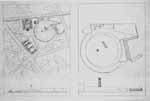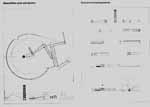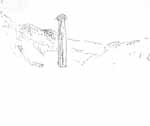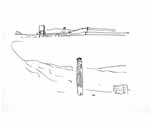![]()




The fragmented sequence from the small plaza—which the project makes
through a group of oblong buildings at the end of the approach street—to
the column within the bowl continues to disrupt one's understanding of
the formal continuity of column and city. Through a series of small tubelike
buildings (their entire cross section is identical with the corridors they
contain), one enters on axis with the column at the center of the plaza's
principal bounding facade, tacks back and forth once into a slotlike corridor
open to the sky, then, once again centered, enters a passage that protrudes
into the slot at an acute angle and ramps down a now-covered passage with
a row of columns down its center. Through one more corridor, now with ceiling
sloped along its length following the slope of the bowl above, one arrives
with another change of direction at a switchback ramp, enclosed but open
to the sky. One finally rises up and out into the bowl—at a point off-center
and off the principal axis, although on a radius defined parallel to a
diagonal street adopted in the arrangement by portions of the project's
geometry. Here one turns right and, looking across the center of the bowl,
sees the column standing off-center to the right. ![]()
The buildings analyzed in plan all belong to one or another of two principal site geometries. However, I imagine that the effect of moving through the building is to distance one from the city through a certain disorientation, and to allow for a passage into the bowl-shaped park in which the column stands—stranded. Here this explicit emblem and trophy of a past architecture stands removed from its own "natural" context—once a component within the syntax and body of a classical building and from its possible normative relationship to the city, established by the classically conceived urban axes, and perceptually undone by the bermed bowl in which it stands isolated—in a garden. Under such conditions it is not unlike those nineteenth-century follies that were merely occasions within the more important order established by the narrative-like sequences of experiences in picturesque garden promenades: in those cases the dominant experience of the folly was not the reconstitution of the historical universe from which the folly came, but a more general and emotive nostalgia for a lost world. Follies, like collections in general, signify not the presence of the collected object so much as the absence of the world from which a relic has been saved. What then is the connection between this project and the purpose to which it is dedicated—a memorial to the victims of the Gestapo? The column appears in the city like some found object of a world lost, its withheld relationship to the larger city only making more poignant the absent world of ordered relationships of which it is an emblem.
The following is possible: The column can be viewed as a relic of a
classical past—possibly of that classical humanist past whose vision assumed
an organic continuity between man and the world, where man remained linked
to the world around him by virtue of the analogy he saw between himself
and the forms of the world. His own subjectivity was not rootless among
the world's autonomous objects and events, ![]() but shared in their order and could thus reform it. He imagined
that the image he held of his own developing rationality could infuse the
world, and if this rationality produced a humane order, then the world
would be humane. Humanism could tame the obdurate alienness of the world
by seeing "the human subject. . . incorporated into the dance of forms
filled by the world" and should not be betrayed by this world. The human
disaster perpetrated by the Third Reich, driven by an image of history
that negated the importance of the individual subject, divides us from
such classical humanist hope. The column, once homologous to man and a
great emblem of the humanist reciprocity between world and subject, is
now only a nostalgic artifact to be collected but incapable of integration
within the city that survived the disaster.
but shared in their order and could thus reform it. He imagined
that the image he held of his own developing rationality could infuse the
world, and if this rationality produced a humane order, then the world
would be humane. Humanism could tame the obdurate alienness of the world
by seeing "the human subject. . . incorporated into the dance of forms
filled by the world" and should not be betrayed by this world. The human
disaster perpetrated by the Third Reich, driven by an image of history
that negated the importance of the individual subject, divides us from
such classical humanist hope. The column, once homologous to man and a
great emblem of the humanist reciprocity between world and subject, is
now only a nostalgic artifact to be collected but incapable of integration
within the city that survived the disaster.
It is also possible that the column is full of more frightening associations derived from its historical association with power, and more particularly with the neoclassical affectations of the Third Reich. In this case, we would stumble upon this symbolic structure collected from the wreckage, defanged in its museological park. Both readings (if not many more) are possible, even in one person. As they oscillate, what remains constant is the remoteness of history, its irrecoverability. When the past is conceived of, it is called history, and at that moment under the glass jar of a name it is as remote as is the world from which the items in a collection have been drawn.
The column is a ruin collected from a lost epoch. The pieces of architecture by which we are brought to it, guided in their layout by the geometry of the surrounding urban site, still gather as if merely part of a series of abutted fragments. By passing through them, we happen upon this lone column. The column, sited by an elaboration of the existing site's order, remains unjoined and alien in the city's midst. Such might be a parable of the memory of those victims within present-day Berlin.
Siza's architecture emerged from an epoch that sought to recover from
the betrayals of language and the misuse of history. The sense of language's
remoteness, the uncertainty of our own relationship to inherited forms
and even to the historical soil on which we build, is codified in an architecture
that joins subject, land, and language, without suggesting that there is
anything natural about such a grouping.
![]() Robert
Levit
Robert
Levit